Investigating Energy Consumption Reduction in Office Buildings
VerifiedAdded on 2023/01/16
|32
|7663
|49
Report
AI Summary
This report investigates energy consumption in office buildings, with a specific focus on the Knowledge Dock building at the University of East London. The research aims to identify methods to reduce energy usage, particularly concerning artificial lighting, which is a significant consumer of electricity in office settings. The study includes a literature review exploring energy consumption, artificial lighting, and relevant policies. The methodology involves a case study approach, data analysis from questionnaires, and a project timeline. The report analyzes energy consumption patterns, evaluates the effectiveness of different lighting systems, and proposes solutions such as the use of building management systems, occupancy sensors, and LED lighting to minimize energy usage and costs. The findings contribute to a better understanding of energy-saving strategies and technologies for a more sustainable approach to office building management. The report also includes questionnaire statistics and figures to support the analysis and conclusions, and concludes with recommendations for future implications.

Last name 1
HOW TO REDUCE THE ENERGY CONSUMPTION INTO THE OFFICE
BUILDINGS
HOW TO REDUCE THE ENERGY CONSUMPTION INTO THE OFFICE
BUILDINGS
Paraphrase This Document
Need a fresh take? Get an instant paraphrase of this document with our AI Paraphraser
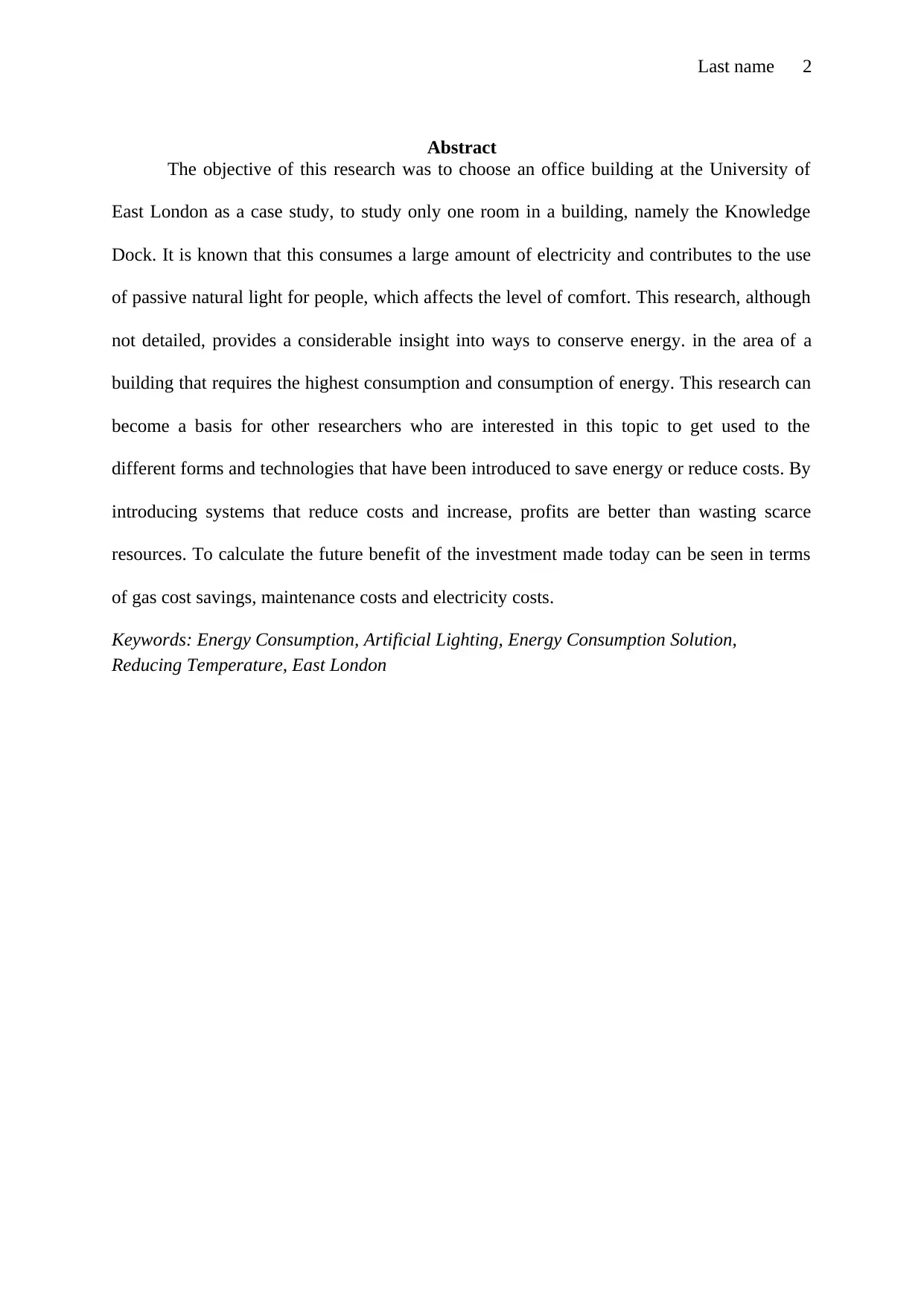
Last name 2
Abstract
The objective of this research was to choose an office building at the University of
East London as a case study, to study only one room in a building, namely the Knowledge
Dock. It is known that this consumes a large amount of electricity and contributes to the use
of passive natural light for people, which affects the level of comfort. This research, although
not detailed, provides a considerable insight into ways to conserve energy. in the area of a
building that requires the highest consumption and consumption of energy. This research can
become a basis for other researchers who are interested in this topic to get used to the
different forms and technologies that have been introduced to save energy or reduce costs. By
introducing systems that reduce costs and increase, profits are better than wasting scarce
resources. To calculate the future benefit of the investment made today can be seen in terms
of gas cost savings, maintenance costs and electricity costs.
Keywords: Energy Consumption, Artificial Lighting, Energy Consumption Solution,
Reducing Temperature, East London
Abstract
The objective of this research was to choose an office building at the University of
East London as a case study, to study only one room in a building, namely the Knowledge
Dock. It is known that this consumes a large amount of electricity and contributes to the use
of passive natural light for people, which affects the level of comfort. This research, although
not detailed, provides a considerable insight into ways to conserve energy. in the area of a
building that requires the highest consumption and consumption of energy. This research can
become a basis for other researchers who are interested in this topic to get used to the
different forms and technologies that have been introduced to save energy or reduce costs. By
introducing systems that reduce costs and increase, profits are better than wasting scarce
resources. To calculate the future benefit of the investment made today can be seen in terms
of gas cost savings, maintenance costs and electricity costs.
Keywords: Energy Consumption, Artificial Lighting, Energy Consumption Solution,
Reducing Temperature, East London
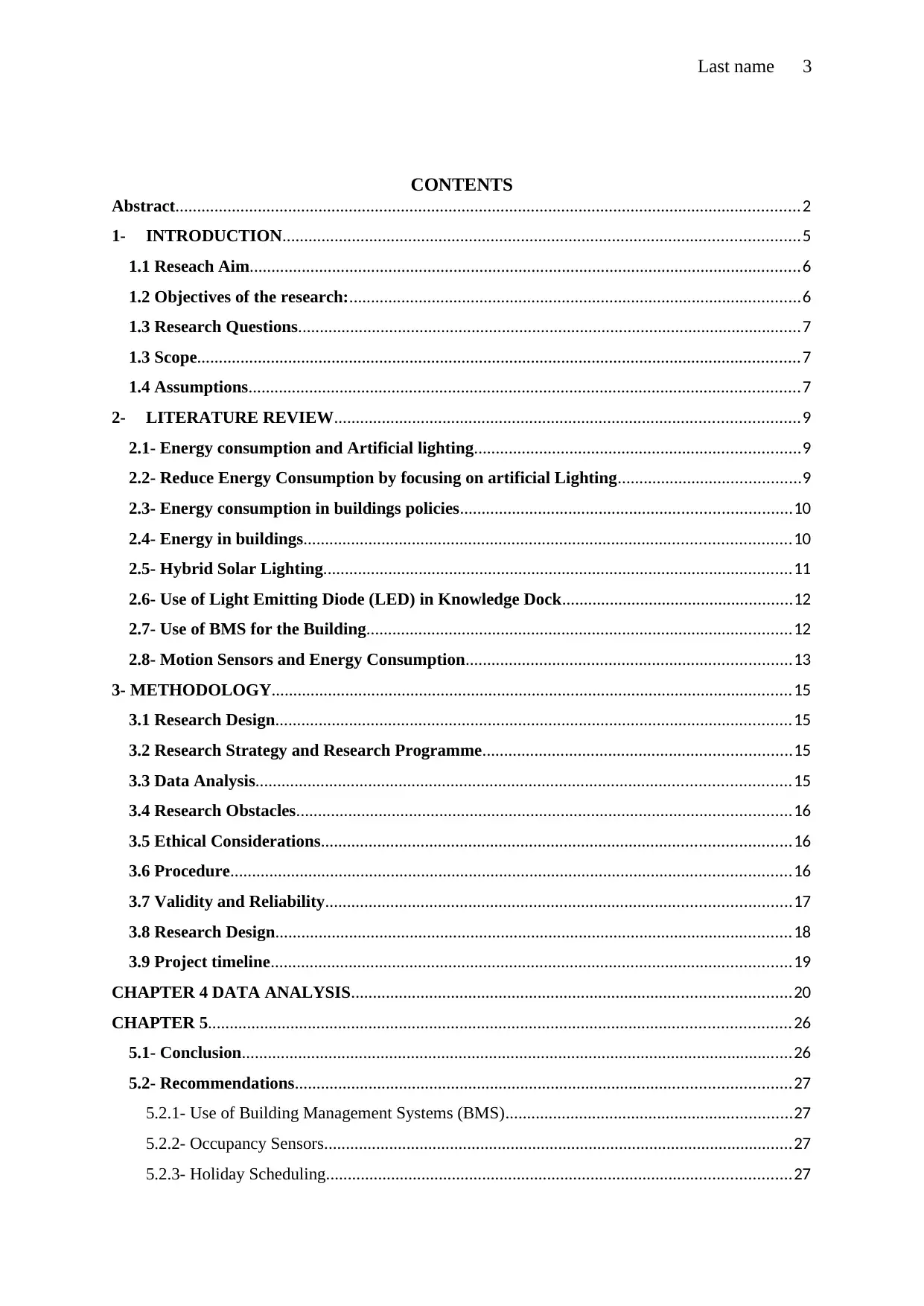
Last name 3
CONTENTS
Abstract................................................................................................................................................2
1- INTRODUCTION.......................................................................................................................5
1.1 Reseach Aim...............................................................................................................................6
1.2 Objectives of the research:........................................................................................................6
1.3 Research Questions....................................................................................................................7
1.3 Scope...........................................................................................................................................7
1.4 Assumptions...............................................................................................................................7
2- LITERATURE REVIEW...........................................................................................................9
2.1- Energy consumption and Artificial lighting...........................................................................9
2.2- Reduce Energy Consumption by focusing on artificial Lighting..........................................9
2.3- Energy consumption in buildings policies............................................................................10
2.4- Energy in buildings................................................................................................................10
2.5- Hybrid Solar Lighting............................................................................................................11
2.6- Use of Light Emitting Diode (LED) in Knowledge Dock.....................................................12
2.7- Use of BMS for the Building..................................................................................................12
2.8- Motion Sensors and Energy Consumption...........................................................................13
3- METHODOLOGY........................................................................................................................15
3.1 Research Design.......................................................................................................................15
3.2 Research Strategy and Research Programme.......................................................................15
3.3 Data Analysis...........................................................................................................................15
3.4 Research Obstacles..................................................................................................................16
3.5 Ethical Considerations............................................................................................................16
3.6 Procedure.................................................................................................................................16
3.7 Validity and Reliability...........................................................................................................17
3.8 Research Design.......................................................................................................................18
3.9 Project timeline........................................................................................................................19
CHAPTER 4 DATA ANALYSIS.....................................................................................................20
CHAPTER 5......................................................................................................................................26
5.1- Conclusion...............................................................................................................................26
5.2- Recommendations..................................................................................................................27
5.2.1- Use of Building Management Systems (BMS)..................................................................27
5.2.2- Occupancy Sensors............................................................................................................27
5.2.3- Holiday Scheduling...........................................................................................................27
CONTENTS
Abstract................................................................................................................................................2
1- INTRODUCTION.......................................................................................................................5
1.1 Reseach Aim...............................................................................................................................6
1.2 Objectives of the research:........................................................................................................6
1.3 Research Questions....................................................................................................................7
1.3 Scope...........................................................................................................................................7
1.4 Assumptions...............................................................................................................................7
2- LITERATURE REVIEW...........................................................................................................9
2.1- Energy consumption and Artificial lighting...........................................................................9
2.2- Reduce Energy Consumption by focusing on artificial Lighting..........................................9
2.3- Energy consumption in buildings policies............................................................................10
2.4- Energy in buildings................................................................................................................10
2.5- Hybrid Solar Lighting............................................................................................................11
2.6- Use of Light Emitting Diode (LED) in Knowledge Dock.....................................................12
2.7- Use of BMS for the Building..................................................................................................12
2.8- Motion Sensors and Energy Consumption...........................................................................13
3- METHODOLOGY........................................................................................................................15
3.1 Research Design.......................................................................................................................15
3.2 Research Strategy and Research Programme.......................................................................15
3.3 Data Analysis...........................................................................................................................15
3.4 Research Obstacles..................................................................................................................16
3.5 Ethical Considerations............................................................................................................16
3.6 Procedure.................................................................................................................................16
3.7 Validity and Reliability...........................................................................................................17
3.8 Research Design.......................................................................................................................18
3.9 Project timeline........................................................................................................................19
CHAPTER 4 DATA ANALYSIS.....................................................................................................20
CHAPTER 5......................................................................................................................................26
5.1- Conclusion...............................................................................................................................26
5.2- Recommendations..................................................................................................................27
5.2.1- Use of Building Management Systems (BMS)..................................................................27
5.2.2- Occupancy Sensors............................................................................................................27
5.2.3- Holiday Scheduling...........................................................................................................27
⊘ This is a preview!⊘
Do you want full access?
Subscribe today to unlock all pages.

Trusted by 1+ million students worldwide
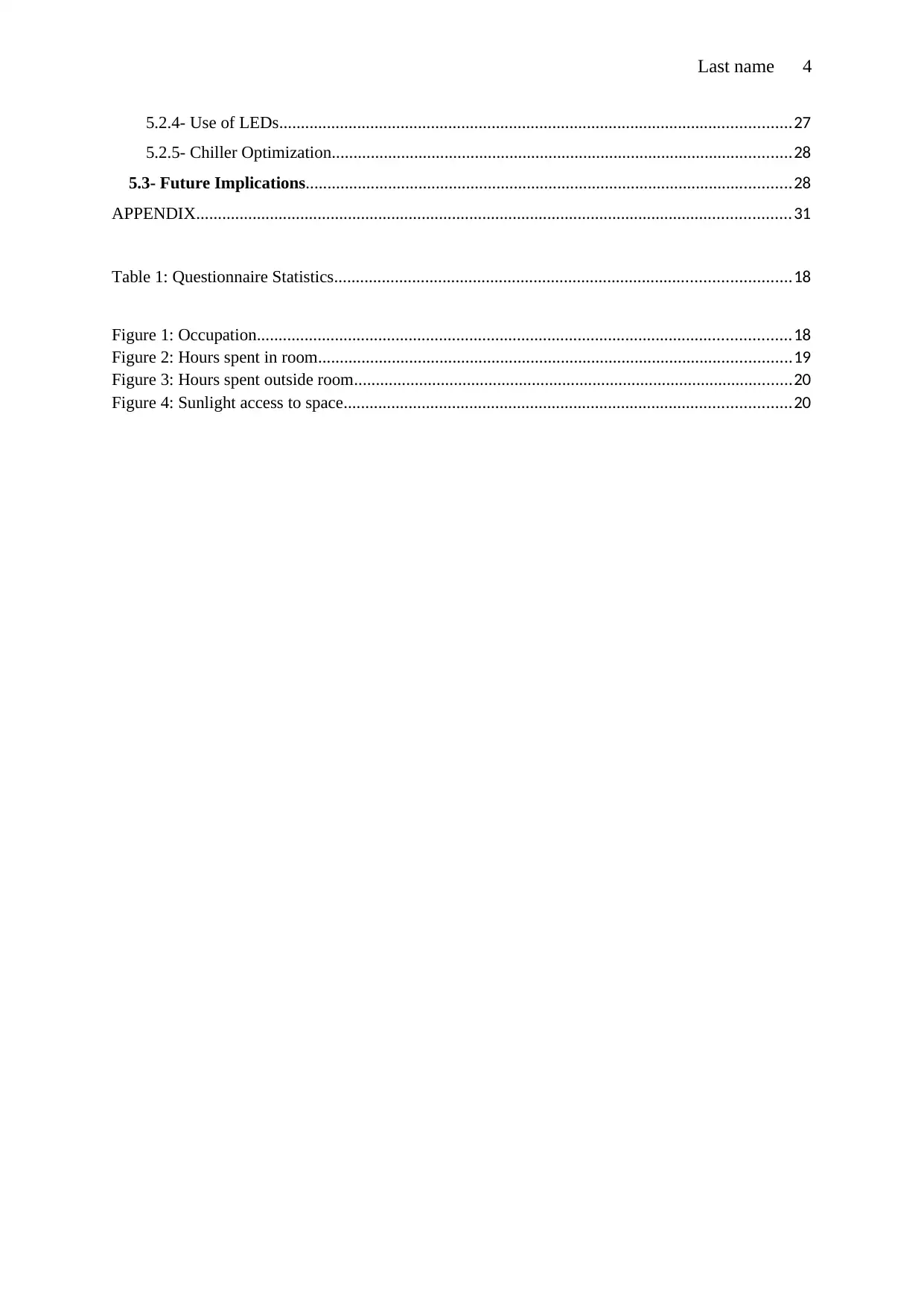
Last name 4
5.2.4- Use of LEDs......................................................................................................................27
5.2.5- Chiller Optimization..........................................................................................................28
5.3- Future Implications................................................................................................................28
APPENDIX.........................................................................................................................................31
Table 1: Questionnaire Statistics.........................................................................................................18
Figure 1: Occupation...........................................................................................................................18
Figure 2: Hours spent in room.............................................................................................................19
Figure 3: Hours spent outside room.....................................................................................................20
Figure 4: Sunlight access to space.......................................................................................................20
5.2.4- Use of LEDs......................................................................................................................27
5.2.5- Chiller Optimization..........................................................................................................28
5.3- Future Implications................................................................................................................28
APPENDIX.........................................................................................................................................31
Table 1: Questionnaire Statistics.........................................................................................................18
Figure 1: Occupation...........................................................................................................................18
Figure 2: Hours spent in room.............................................................................................................19
Figure 3: Hours spent outside room.....................................................................................................20
Figure 4: Sunlight access to space.......................................................................................................20
Paraphrase This Document
Need a fresh take? Get an instant paraphrase of this document with our AI Paraphraser
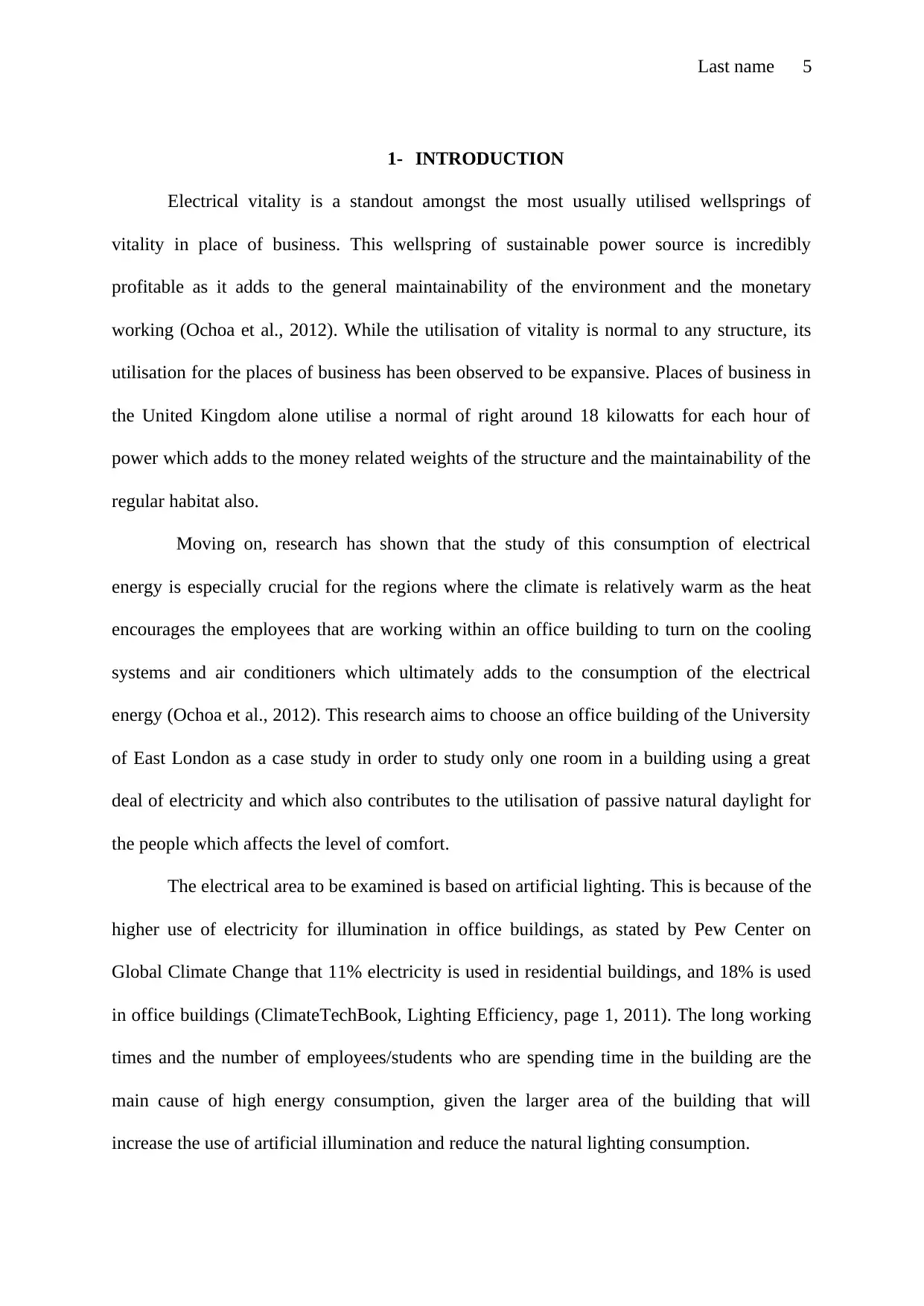
Last name 5
1- INTRODUCTION
Electrical vitality is a standout amongst the most usually utilised wellsprings of
vitality in place of business. This wellspring of sustainable power source is incredibly
profitable as it adds to the general maintainability of the environment and the monetary
working (Ochoa et al., 2012). While the utilisation of vitality is normal to any structure, its
utilisation for the places of business has been observed to be expansive. Places of business in
the United Kingdom alone utilise a normal of right around 18 kilowatts for each hour of
power which adds to the money related weights of the structure and the maintainability of the
regular habitat also.
Moving on, research has shown that the study of this consumption of electrical
energy is especially crucial for the regions where the climate is relatively warm as the heat
encourages the employees that are working within an office building to turn on the cooling
systems and air conditioners which ultimately adds to the consumption of the electrical
energy (Ochoa et al., 2012). This research aims to choose an office building of the University
of East London as a case study in order to study only one room in a building using a great
deal of electricity and which also contributes to the utilisation of passive natural daylight for
the people which affects the level of comfort.
The electrical area to be examined is based on artificial lighting. This is because of the
higher use of electricity for illumination in office buildings, as stated by Pew Center on
Global Climate Change that 11% electricity is used in residential buildings, and 18% is used
in office buildings (ClimateTechBook, Lighting Efficiency, page 1, 2011). The long working
times and the number of employees/students who are spending time in the building are the
main cause of high energy consumption, given the larger area of the building that will
increase the use of artificial illumination and reduce the natural lighting consumption.
1- INTRODUCTION
Electrical vitality is a standout amongst the most usually utilised wellsprings of
vitality in place of business. This wellspring of sustainable power source is incredibly
profitable as it adds to the general maintainability of the environment and the monetary
working (Ochoa et al., 2012). While the utilisation of vitality is normal to any structure, its
utilisation for the places of business has been observed to be expansive. Places of business in
the United Kingdom alone utilise a normal of right around 18 kilowatts for each hour of
power which adds to the money related weights of the structure and the maintainability of the
regular habitat also.
Moving on, research has shown that the study of this consumption of electrical
energy is especially crucial for the regions where the climate is relatively warm as the heat
encourages the employees that are working within an office building to turn on the cooling
systems and air conditioners which ultimately adds to the consumption of the electrical
energy (Ochoa et al., 2012). This research aims to choose an office building of the University
of East London as a case study in order to study only one room in a building using a great
deal of electricity and which also contributes to the utilisation of passive natural daylight for
the people which affects the level of comfort.
The electrical area to be examined is based on artificial lighting. This is because of the
higher use of electricity for illumination in office buildings, as stated by Pew Center on
Global Climate Change that 11% electricity is used in residential buildings, and 18% is used
in office buildings (ClimateTechBook, Lighting Efficiency, page 1, 2011). The long working
times and the number of employees/students who are spending time in the building are the
main cause of high energy consumption, given the larger area of the building that will
increase the use of artificial illumination and reduce the natural lighting consumption.
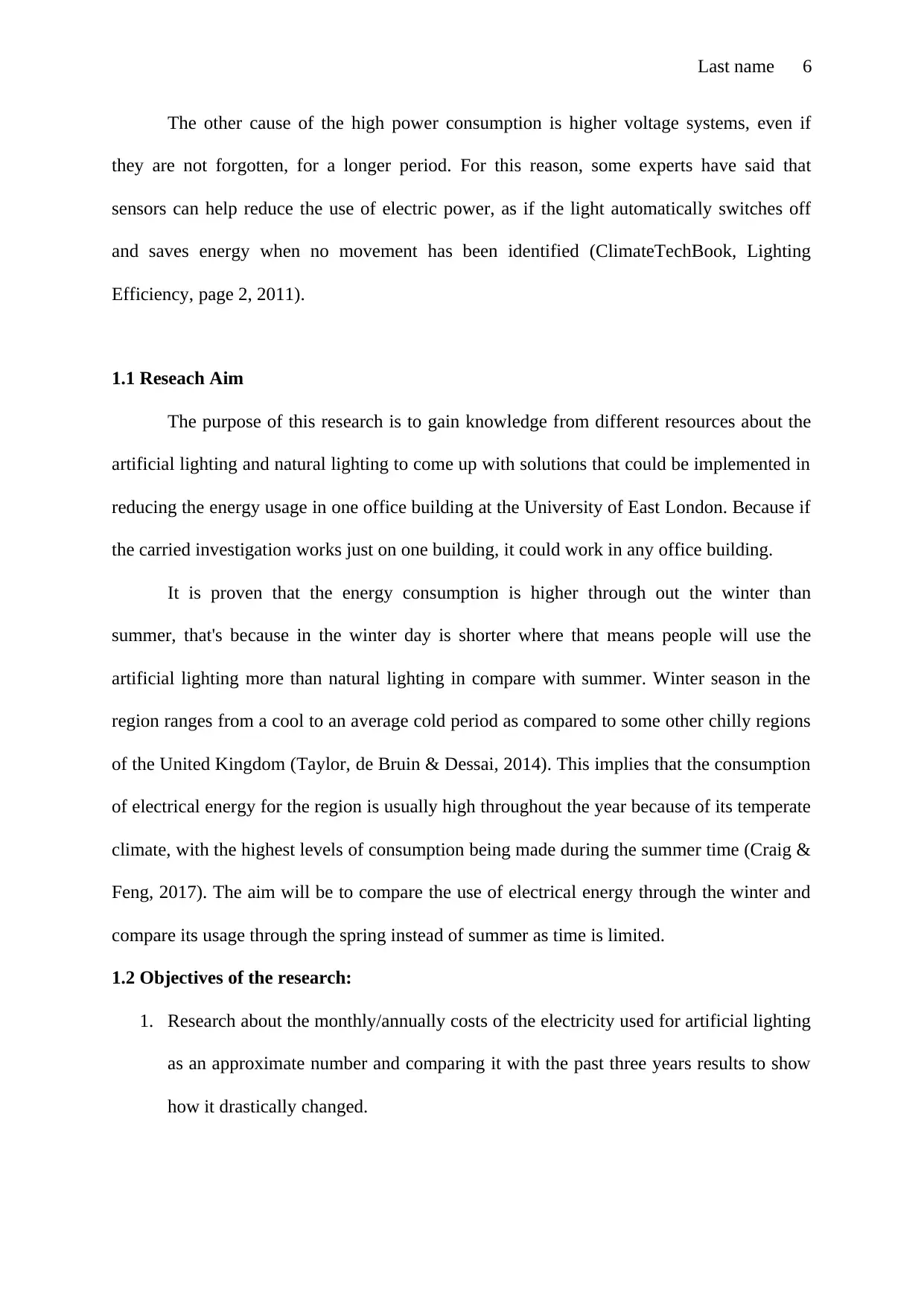
Last name 6
The other cause of the high power consumption is higher voltage systems, even if
they are not forgotten, for a longer period. For this reason, some experts have said that
sensors can help reduce the use of electric power, as if the light automatically switches off
and saves energy when no movement has been identified (ClimateTechBook, Lighting
Efficiency, page 2, 2011).
1.1 Reseach Aim
The purpose of this research is to gain knowledge from different resources about the
artificial lighting and natural lighting to come up with solutions that could be implemented in
reducing the energy usage in one office building at the University of East London. Because if
the carried investigation works just on one building, it could work in any office building.
It is proven that the energy consumption is higher through out the winter than
summer, that's because in the winter day is shorter where that means people will use the
artificial lighting more than natural lighting in compare with summer. Winter season in the
region ranges from a cool to an average cold period as compared to some other chilly regions
of the United Kingdom (Taylor, de Bruin & Dessai, 2014). This implies that the consumption
of electrical energy for the region is usually high throughout the year because of its temperate
climate, with the highest levels of consumption being made during the summer time (Craig &
Feng, 2017). The aim will be to compare the use of electrical energy through the winter and
compare its usage through the spring instead of summer as time is limited.
1.2 Objectives of the research:
1. Research about the monthly/annually costs of the electricity used for artificial lighting
as an approximate number and comparing it with the past three years results to show
how it drastically changed.
The other cause of the high power consumption is higher voltage systems, even if
they are not forgotten, for a longer period. For this reason, some experts have said that
sensors can help reduce the use of electric power, as if the light automatically switches off
and saves energy when no movement has been identified (ClimateTechBook, Lighting
Efficiency, page 2, 2011).
1.1 Reseach Aim
The purpose of this research is to gain knowledge from different resources about the
artificial lighting and natural lighting to come up with solutions that could be implemented in
reducing the energy usage in one office building at the University of East London. Because if
the carried investigation works just on one building, it could work in any office building.
It is proven that the energy consumption is higher through out the winter than
summer, that's because in the winter day is shorter where that means people will use the
artificial lighting more than natural lighting in compare with summer. Winter season in the
region ranges from a cool to an average cold period as compared to some other chilly regions
of the United Kingdom (Taylor, de Bruin & Dessai, 2014). This implies that the consumption
of electrical energy for the region is usually high throughout the year because of its temperate
climate, with the highest levels of consumption being made during the summer time (Craig &
Feng, 2017). The aim will be to compare the use of electrical energy through the winter and
compare its usage through the spring instead of summer as time is limited.
1.2 Objectives of the research:
1. Research about the monthly/annually costs of the electricity used for artificial lighting
as an approximate number and comparing it with the past three years results to show
how it drastically changed.
⊘ This is a preview!⊘
Do you want full access?
Subscribe today to unlock all pages.

Trusted by 1+ million students worldwide
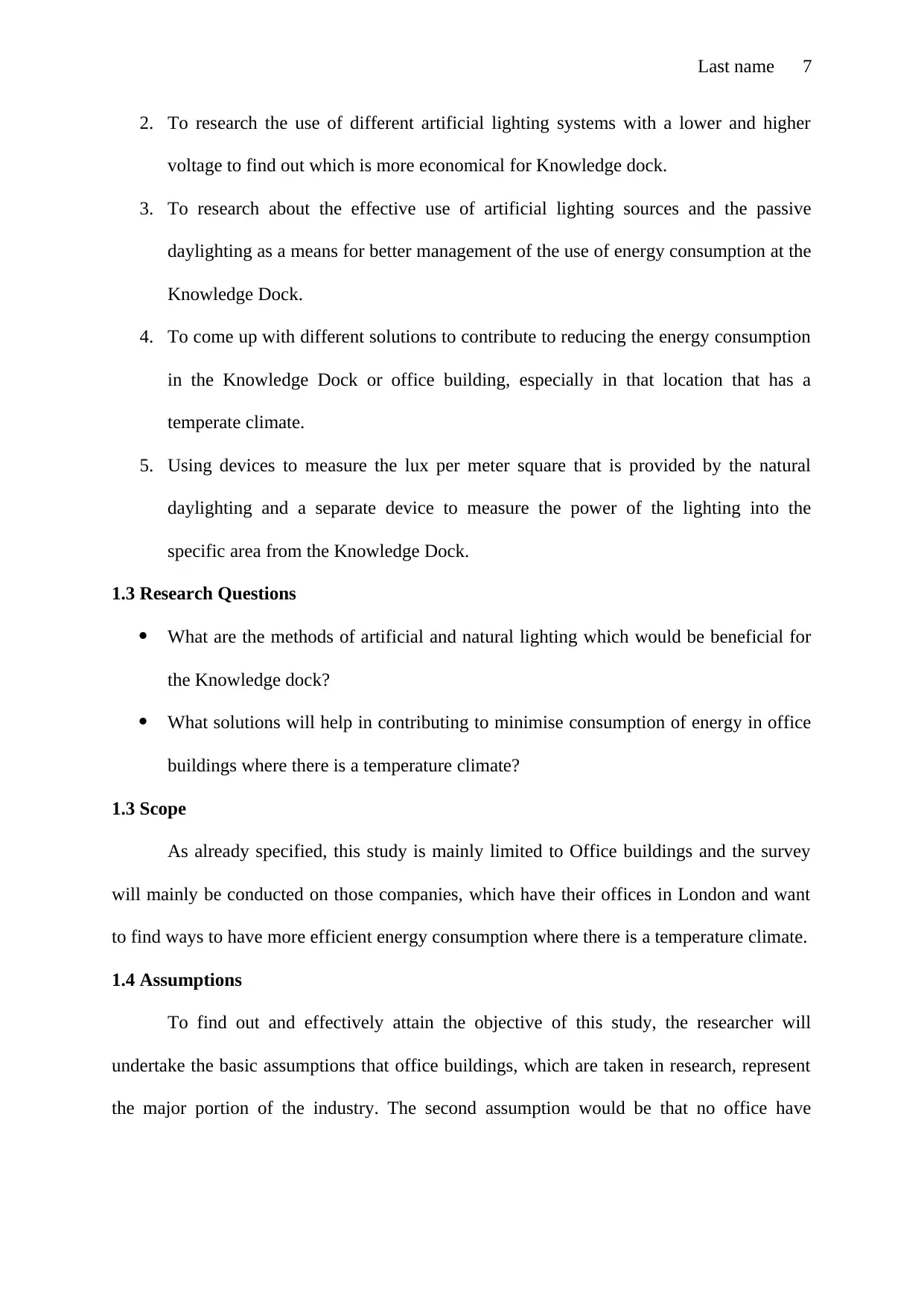
Last name 7
2. To research the use of different artificial lighting systems with a lower and higher
voltage to find out which is more economical for Knowledge dock.
3. To research about the effective use of artificial lighting sources and the passive
daylighting as a means for better management of the use of energy consumption at the
Knowledge Dock.
4. To come up with different solutions to contribute to reducing the energy consumption
in the Knowledge Dock or office building, especially in that location that has a
temperate climate.
5. Using devices to measure the lux per meter square that is provided by the natural
daylighting and a separate device to measure the power of the lighting into the
specific area from the Knowledge Dock.
1.3 Research Questions
What are the methods of artificial and natural lighting which would be beneficial for
the Knowledge dock?
What solutions will help in contributing to minimise consumption of energy in office
buildings where there is a temperature climate?
1.3 Scope
As already specified, this study is mainly limited to Office buildings and the survey
will mainly be conducted on those companies, which have their offices in London and want
to find ways to have more efficient energy consumption where there is a temperature climate.
1.4 Assumptions
To find out and effectively attain the objective of this study, the researcher will
undertake the basic assumptions that office buildings, which are taken in research, represent
the major portion of the industry. The second assumption would be that no office have
2. To research the use of different artificial lighting systems with a lower and higher
voltage to find out which is more economical for Knowledge dock.
3. To research about the effective use of artificial lighting sources and the passive
daylighting as a means for better management of the use of energy consumption at the
Knowledge Dock.
4. To come up with different solutions to contribute to reducing the energy consumption
in the Knowledge Dock or office building, especially in that location that has a
temperate climate.
5. Using devices to measure the lux per meter square that is provided by the natural
daylighting and a separate device to measure the power of the lighting into the
specific area from the Knowledge Dock.
1.3 Research Questions
What are the methods of artificial and natural lighting which would be beneficial for
the Knowledge dock?
What solutions will help in contributing to minimise consumption of energy in office
buildings where there is a temperature climate?
1.3 Scope
As already specified, this study is mainly limited to Office buildings and the survey
will mainly be conducted on those companies, which have their offices in London and want
to find ways to have more efficient energy consumption where there is a temperature climate.
1.4 Assumptions
To find out and effectively attain the objective of this study, the researcher will
undertake the basic assumptions that office buildings, which are taken in research, represent
the major portion of the industry. The second assumption would be that no office have
Paraphrase This Document
Need a fresh take? Get an instant paraphrase of this document with our AI Paraphraser

Last name 8
inefficient energy consumption throughout the time of research, to avoid any kind of
disruption.
inefficient energy consumption throughout the time of research, to avoid any kind of
disruption.

Last name 9
2- LITERATURE REVIEW
2.1- Energy consumption and Artificial lighting
The difficulties as far as supportability as far as conservation of energy and protecting
the environment are colossal and will require real changes, not exclusively to how vitality is
given yet in addition to how it is expended. Then again, the close connection among energy
and monetary improvement gives ascend, without its industry and end-use evaluation,
categorization, and non-stop checking, to a need to comprehend and monitor the use of
energy.Even if many organisations are making great efforts to supply adequate energy
consumption information around the world, the clear picture of this target is scarce for the
global cooperation of nations, organisations, and agencies.
Due to its large energy consumption and associated consumption, particular emphasis
is on the characteristics of the building sector Delvaeye et al. (2016) presented an analysis of
the use of energy in residential and commercial buildings based on available information for
the 2004 period with detailed breakdowns and special emphasis on HVAC systems in a
previously interesting report. This is for the Knowledge Dock’s efficient functionality and
energy conservation (Saunders & Lewis, 2012).
2.2- Reduce Energy Consumption by focusing on artificial Lighting
These systems benefit from the possibility of dynamic daylighting and artificial
lighting in internal parts of buildings and energy saving. It is necessary to change the
structure to make it an energy efficient building, replace the machine with energy efficient
machinery, which requires the building designing (Shishegar & Boubekri, 2017). The
reduction in energy consumption for heat, ventilation and artificial lighting can help reduce
energy savings in buildings. An energy-efficient manner can develop a building in
accordance with solar radiation and daylight. Saving electricity for permanent artificial
2- LITERATURE REVIEW
2.1- Energy consumption and Artificial lighting
The difficulties as far as supportability as far as conservation of energy and protecting
the environment are colossal and will require real changes, not exclusively to how vitality is
given yet in addition to how it is expended. Then again, the close connection among energy
and monetary improvement gives ascend, without its industry and end-use evaluation,
categorization, and non-stop checking, to a need to comprehend and monitor the use of
energy.Even if many organisations are making great efforts to supply adequate energy
consumption information around the world, the clear picture of this target is scarce for the
global cooperation of nations, organisations, and agencies.
Due to its large energy consumption and associated consumption, particular emphasis
is on the characteristics of the building sector Delvaeye et al. (2016) presented an analysis of
the use of energy in residential and commercial buildings based on available information for
the 2004 period with detailed breakdowns and special emphasis on HVAC systems in a
previously interesting report. This is for the Knowledge Dock’s efficient functionality and
energy conservation (Saunders & Lewis, 2012).
2.2- Reduce Energy Consumption by focusing on artificial Lighting
These systems benefit from the possibility of dynamic daylighting and artificial
lighting in internal parts of buildings and energy saving. It is necessary to change the
structure to make it an energy efficient building, replace the machine with energy efficient
machinery, which requires the building designing (Shishegar & Boubekri, 2017). The
reduction in energy consumption for heat, ventilation and artificial lighting can help reduce
energy savings in buildings. An energy-efficient manner can develop a building in
accordance with solar radiation and daylight. Saving electricity for permanent artificial
⊘ This is a preview!⊘
Do you want full access?
Subscribe today to unlock all pages.

Trusted by 1+ million students worldwide
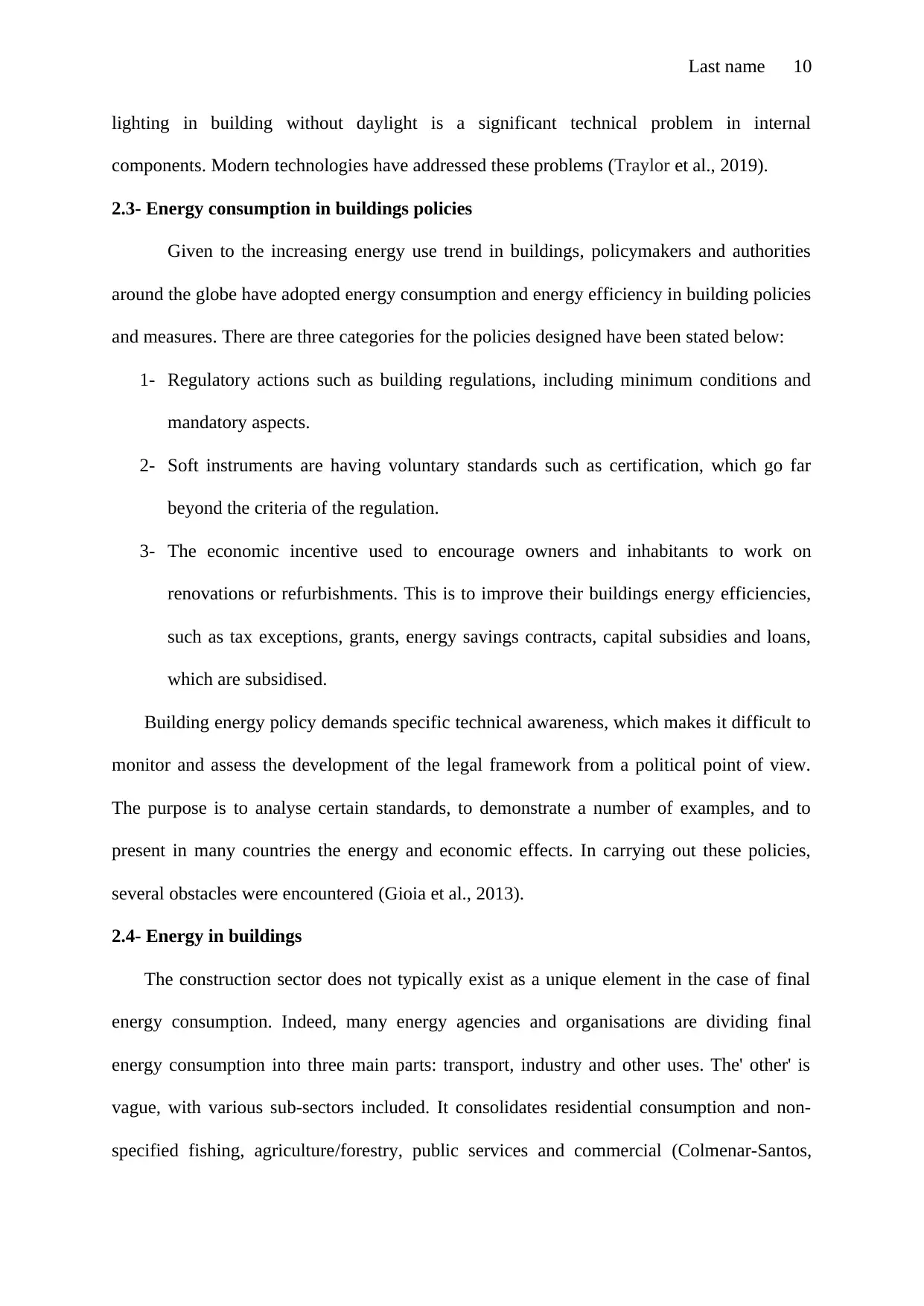
Last name 10
lighting in building without daylight is a significant technical problem in internal
components. Modern technologies have addressed these problems (Traylor et al., 2019).
2.3- Energy consumption in buildings policies
Given to the increasing energy use trend in buildings, policymakers and authorities
around the globe have adopted energy consumption and energy efficiency in building policies
and measures. There are three categories for the policies designed have been stated below:
1- Regulatory actions such as building regulations, including minimum conditions and
mandatory aspects.
2- Soft instruments are having voluntary standards such as certification, which go far
beyond the criteria of the regulation.
3- The economic incentive used to encourage owners and inhabitants to work on
renovations or refurbishments. This is to improve their buildings energy efficiencies,
such as tax exceptions, grants, energy savings contracts, capital subsidies and loans,
which are subsidised.
Building energy policy demands specific technical awareness, which makes it difficult to
monitor and assess the development of the legal framework from a political point of view.
The purpose is to analyse certain standards, to demonstrate a number of examples, and to
present in many countries the energy and economic effects. In carrying out these policies,
several obstacles were encountered (Gioia et al., 2013).
2.4- Energy in buildings
The construction sector does not typically exist as a unique element in the case of final
energy consumption. Indeed, many energy agencies and organisations are dividing final
energy consumption into three main parts: transport, industry and other uses. The' other' is
vague, with various sub-sectors included. It consolidates residential consumption and non-
specified fishing, agriculture/forestry, public services and commercial (Colmenar-Santos,
lighting in building without daylight is a significant technical problem in internal
components. Modern technologies have addressed these problems (Traylor et al., 2019).
2.3- Energy consumption in buildings policies
Given to the increasing energy use trend in buildings, policymakers and authorities
around the globe have adopted energy consumption and energy efficiency in building policies
and measures. There are three categories for the policies designed have been stated below:
1- Regulatory actions such as building regulations, including minimum conditions and
mandatory aspects.
2- Soft instruments are having voluntary standards such as certification, which go far
beyond the criteria of the regulation.
3- The economic incentive used to encourage owners and inhabitants to work on
renovations or refurbishments. This is to improve their buildings energy efficiencies,
such as tax exceptions, grants, energy savings contracts, capital subsidies and loans,
which are subsidised.
Building energy policy demands specific technical awareness, which makes it difficult to
monitor and assess the development of the legal framework from a political point of view.
The purpose is to analyse certain standards, to demonstrate a number of examples, and to
present in many countries the energy and economic effects. In carrying out these policies,
several obstacles were encountered (Gioia et al., 2013).
2.4- Energy in buildings
The construction sector does not typically exist as a unique element in the case of final
energy consumption. Indeed, many energy agencies and organisations are dividing final
energy consumption into three main parts: transport, industry and other uses. The' other' is
vague, with various sub-sectors included. It consolidates residential consumption and non-
specified fishing, agriculture/forestry, public services and commercial (Colmenar-Santos,
Paraphrase This Document
Need a fresh take? Get an instant paraphrase of this document with our AI Paraphraser

Last name 11
2013). As a result, quantification of energy consumption was frequently, not well assessed in
buildings. However, for much of the energy consumed in buildings with many kinds the other
industry is responsible. The total energy consumption of commercial and residential buildings
in Europe accounts for 40 per cent (Cao et al., 2016; Susorova et al., 2013).
Therefore, a range of initiatives for reducing energy consumption was awarded in the
revision of the Energy Performance Building Directive launched by the European Parliament
and the Council in 2002. As already mentioned, the ultimate energy consumption depends on
time (Colmenar-Santos, 2013). The EU has, for example, seen an increase in building
consumption, nearly 1% per annum since 90, especially for residential buildings, mainly for
non-residential buildings (1.5% annually for non-residential buildings versus 0.6% annually
for households)(Cao et al., 2016).
This predict of consumption is also so complicated because of its uncontrollable aspects
of influence factors such as improvement of building services; the distribution of human
activities; and the dislocation linked to population growth is aside from the unpredictability
of evaluating statistical data. Thus, many recent, advanced and simplified mathematical
models have been developed (Manzan & Clarich, 2017).
2.5- Hybrid Solar Lighting
In the new technology, the visible portion of solar power transmitted by a solar
collector to light-fitting optical cables and piped into building interiors. Controllers monitor
solar light availability and add fluorescence lights, if necessary, to provide the required levels
of lighting at any place.Early tests demonstrate that hybrid lighting is a doable choice in the
main two stories of most of business structures. A solar panel which gathers energy on the
rooftop can be utilized to expel noticeable light from infrared radiation and to utilize the
obvious light for different purposes, for example, power, boiling water warming or a spatial
warming unit. This is plausible for energy generation also. Since energy is split, less heat is
2013). As a result, quantification of energy consumption was frequently, not well assessed in
buildings. However, for much of the energy consumed in buildings with many kinds the other
industry is responsible. The total energy consumption of commercial and residential buildings
in Europe accounts for 40 per cent (Cao et al., 2016; Susorova et al., 2013).
Therefore, a range of initiatives for reducing energy consumption was awarded in the
revision of the Energy Performance Building Directive launched by the European Parliament
and the Council in 2002. As already mentioned, the ultimate energy consumption depends on
time (Colmenar-Santos, 2013). The EU has, for example, seen an increase in building
consumption, nearly 1% per annum since 90, especially for residential buildings, mainly for
non-residential buildings (1.5% annually for non-residential buildings versus 0.6% annually
for households)(Cao et al., 2016).
This predict of consumption is also so complicated because of its uncontrollable aspects
of influence factors such as improvement of building services; the distribution of human
activities; and the dislocation linked to population growth is aside from the unpredictability
of evaluating statistical data. Thus, many recent, advanced and simplified mathematical
models have been developed (Manzan & Clarich, 2017).
2.5- Hybrid Solar Lighting
In the new technology, the visible portion of solar power transmitted by a solar
collector to light-fitting optical cables and piped into building interiors. Controllers monitor
solar light availability and add fluorescence lights, if necessary, to provide the required levels
of lighting at any place.Early tests demonstrate that hybrid lighting is a doable choice in the
main two stories of most of business structures. A solar panel which gathers energy on the
rooftop can be utilized to expel noticeable light from infrared radiation and to utilize the
obvious light for different purposes, for example, power, boiling water warming or a spatial
warming unit. This is plausible for energy generation also. Since energy is split, less heat is

Last name 12
wasted, instead of other items in the building that consume energy. While the development
and demonstration of hybrid solar lighting systems in various installations is not yet
economically competitive with most other options of lighting (Rattananavathong et al., 2017).
2.6- Use of Light Emitting Diode (LED) in Knowledge Dock
Electrons (atoms lacking an electron) combine in light-emitting diodes and release
energy as light. The technology has been around for several decades, but many lighting LED
applications have only recently become commercially accessible with the development of
improved colour renderings and a reduction in costs. LED fixtures to use between 75 and
80% less electricity than incandescent bulbs, with the lifetime of the light bulbs being 25
times longer. Depending on the LED type, LEDs produce between 27-150 lumens per watt.
LEDs have a small, very high-bright bulb and due to their size, LED fixtures are used for
special purposes, such as decorative lighting or functional lighting in areas that can be
difficult to reach, such as streak lights, exterior lighting, display illumination, stairway
lighting, etc. LEDs are longer lasting than most other light alternatives and are more
controllable because the light is focused and the LED dimmed in a particular direction(Li et
al., 2001).
2.7- Use of BMS for the Building
Using Building Management Systems (BMS) as a platforms which helps to monitor
and control mechanical and electrical devices of building. This helps in increase efficiency
and reduce power consumption by installing the software in the building. This enables
managers to react quickly to changes in energy demand. The DMP or Demand Management
Program is a golden change to avail energy-efficient technology. This is known to improve
and help with the building's operational performance and reduce electricity demand. These
systems enable building managers or operators to control equipment more seamlessly by
means of one system, improving operational effectiveness. This permits the use of energy
wasted, instead of other items in the building that consume energy. While the development
and demonstration of hybrid solar lighting systems in various installations is not yet
economically competitive with most other options of lighting (Rattananavathong et al., 2017).
2.6- Use of Light Emitting Diode (LED) in Knowledge Dock
Electrons (atoms lacking an electron) combine in light-emitting diodes and release
energy as light. The technology has been around for several decades, but many lighting LED
applications have only recently become commercially accessible with the development of
improved colour renderings and a reduction in costs. LED fixtures to use between 75 and
80% less electricity than incandescent bulbs, with the lifetime of the light bulbs being 25
times longer. Depending on the LED type, LEDs produce between 27-150 lumens per watt.
LEDs have a small, very high-bright bulb and due to their size, LED fixtures are used for
special purposes, such as decorative lighting or functional lighting in areas that can be
difficult to reach, such as streak lights, exterior lighting, display illumination, stairway
lighting, etc. LEDs are longer lasting than most other light alternatives and are more
controllable because the light is focused and the LED dimmed in a particular direction(Li et
al., 2001).
2.7- Use of BMS for the Building
Using Building Management Systems (BMS) as a platforms which helps to monitor
and control mechanical and electrical devices of building. This helps in increase efficiency
and reduce power consumption by installing the software in the building. This enables
managers to react quickly to changes in energy demand. The DMP or Demand Management
Program is a golden change to avail energy-efficient technology. This is known to improve
and help with the building's operational performance and reduce electricity demand. These
systems enable building managers or operators to control equipment more seamlessly by
means of one system, improving operational effectiveness. This permits the use of energy
⊘ This is a preview!⊘
Do you want full access?
Subscribe today to unlock all pages.

Trusted by 1+ million students worldwide
1 out of 32
Related Documents
Your All-in-One AI-Powered Toolkit for Academic Success.
+13062052269
info@desklib.com
Available 24*7 on WhatsApp / Email
![[object Object]](/_next/static/media/star-bottom.7253800d.svg)
Unlock your academic potential
Copyright © 2020–2025 A2Z Services. All Rights Reserved. Developed and managed by ZUCOL.





